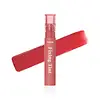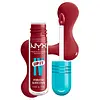What's inside
What's inside
 Key Ingredients
Key Ingredients

 Benefits
Benefits

 Concerns
Concerns

 Ingredients Side-by-side
Ingredients Side-by-side

Water
Skin ConditioningIsododecane
EmollientDimethicone
EmollientVinyl Dimethicone/Methicone Silsesquioxane Crosspolymer
Butylene Glycol
HumectantDisteardimonium Hectorite
StabilisingTricalcium Phosphate
AbrasiveDimethicone/Vinyl Dimethicone Crosspolymer
Skin ConditioningSorbitan Isostearate
EmulsifyingLauryl Polyglyceryl-3 Polydimethylsiloxyethyl Dimethicone
Skin ConditioningDiisostearyl Malate
EmollientDiglycerin
HumectantCetyl PEG/PPG-10/1 Dimethicone
EmulsifyingStearyl Dimethicone
EmollientMagnesium Sulfate
Diphenylsiloxy Phenyl Trimethicone
Skin ConditioningPropylene Carbonate
SolventCI 77891
Cosmetic ColorantCI 15850
Cosmetic ColorantPolyglyceryl-3 Diisostearate
EmulsifyingOctadecene
SolventAcrylates/Polytrimethylsiloxymethacrylate Copolymer
Skin ConditioningCI 19140
Cosmetic ColorantPolyglyceryl-3 Polydimethylsiloxyethyl Dimethicone
Skin ConditioningParfum
MaskingSorbitan Olivate
EmulsifyingSilica Dimethyl Silylate
EmollientCI 77491
Cosmetic ColorantCI 15985
Cosmetic ColorantTriethoxycaprylylsilane
CI 45410
Cosmetic ColorantSorbitan Sesquioleate
EmulsifyingEthylhexylglycerin
Skin ConditioningCI 42090
Cosmetic ColorantTocopherol
AntioxidantPentaerythrityl Tetra-Di-T-Butyl Hydroxyhydrocinnamate
AntioxidantWater, Isododecane, Dimethicone, Vinyl Dimethicone/Methicone Silsesquioxane Crosspolymer, Butylene Glycol, Disteardimonium Hectorite, Tricalcium Phosphate, Dimethicone/Vinyl Dimethicone Crosspolymer, Sorbitan Isostearate, Lauryl Polyglyceryl-3 Polydimethylsiloxyethyl Dimethicone, Diisostearyl Malate, Diglycerin, Cetyl PEG/PPG-10/1 Dimethicone, Stearyl Dimethicone, Magnesium Sulfate, Diphenylsiloxy Phenyl Trimethicone, Propylene Carbonate, CI 77891, CI 15850, Polyglyceryl-3 Diisostearate, Octadecene, Acrylates/Polytrimethylsiloxymethacrylate Copolymer, CI 19140, Polyglyceryl-3 Polydimethylsiloxyethyl Dimethicone, Parfum, Sorbitan Olivate, Silica Dimethyl Silylate, CI 77491, CI 15985, Triethoxycaprylylsilane, CI 45410, Sorbitan Sesquioleate, Ethylhexylglycerin, CI 42090, Tocopherol, Pentaerythrityl Tetra-Di-T-Butyl Hydroxyhydrocinnamate
Water
Skin ConditioningDiisostearyl Malate
EmollientPolyglyceryl-2 Triisostearate
EmulsifyingGlycerin
HumectantBis-Behenyl/Isostearyl/Phytosteryl Dimer Dilinoleyl Dimer Dilinoleate
EmollientOctyldodecanol
EmollientCetyl PEG/PPG-10/1 Dimethicone
EmulsifyingPolyglyceryl-6 Polyhydroxystearate
EmulsifyingPolyglyceryl-6 Polyricinoleate
EmulsifyingSynthetic Wax
AbrasiveCI 77891
Cosmetic Colorant1,2-Hexanediol
Skin ConditioningSodium Chloride
MaskingDicaprylyl Carbonate
EmollientPhenoxyethanol
PreservativeDisteardimonium Hectorite
StabilisingEthylcellulose
Ethylene/Propylene Copolymer
AbrasiveCaprylyl Glycol
EmollientPolyglycerin-6
HumectantCI 19140
Cosmetic ColorantMagnesium Sulfate
CI 17200
Cosmetic ColorantCI 15985
Cosmetic ColorantAroma
CI 45410
Cosmetic ColorantCI 42090
Cosmetic ColorantCyanocobalamin
Skin ConditioningTocopherol
AntioxidantPentaerythrityl Tetra-Di-T-Butyl Hydroxyhydrocinnamate
AntioxidantCocos Nucifera Oil
MaskingWater, Diisostearyl Malate, Polyglyceryl-2 Triisostearate, Glycerin, Bis-Behenyl/Isostearyl/Phytosteryl Dimer Dilinoleyl Dimer Dilinoleate, Octyldodecanol, Cetyl PEG/PPG-10/1 Dimethicone, Polyglyceryl-6 Polyhydroxystearate, Polyglyceryl-6 Polyricinoleate, Synthetic Wax, CI 77891, 1,2-Hexanediol, Sodium Chloride, Dicaprylyl Carbonate, Phenoxyethanol, Disteardimonium Hectorite, Ethylcellulose, Ethylene/Propylene Copolymer, Caprylyl Glycol, Polyglycerin-6, CI 19140, Magnesium Sulfate, CI 17200, CI 15985, Aroma, CI 45410, CI 42090, Cyanocobalamin, Tocopherol, Pentaerythrityl Tetra-Di-T-Butyl Hydroxyhydrocinnamate, Cocos Nucifera Oil
 Reviews
Reviews

Ingredients Explained
These ingredients are found in both products.
Ingredients higher up in an ingredient list are typically present in a larger amount.
This ingredient is a high molecular weight silicone. It has emulsifying and skin conditioning properties.
Ci 15985 is a dye made from petroleum. It is synthetically created and approved by the FDA for use in foods and cosmetics.
The color of this dye is orange/yellow.
This ingredient can be found in makeup, sun care, and skincare.
Learn more about CI 15985CI 19140 is also known as Tartrazine. Tartrazine is a synthetic dye used in cosmetics, foods, and medicine to add a yellow color.
Tartrazine is created from petroleum and is water-soluble.
Some people may experience allergies from this dye, especially asthmatics and those with an aspirin intolerance.
Learn more about CI 19140Ci 42090 is a synthetic dye created from petroleum. It is used to give a bright blue color to cosmetics, medicine, and food.
CI 45410 is a synthetic red-pigment and dye.
It often goes by both Red 28 or Red 27; manufacturers label both ingredients as CI 45410.
This dye is commonly found in makeup because it imparts a vivid color. Some types of this dye change color based on pH level and interaction with moisture:
Your skin has a natural pH of around 4.5 - 5.5.
According to the FDA, CI 45410 is not permitted for use in eye products.
Red 27 is a flourescein dye and commonly used as a fluorescent tracer in medicine.
Learn more about CI 45410Ci 77891 is a white pigment from Titanium dioxide. It is naturally found in minerals such as rutile and ilmenite.
It's main function is to add a white color to cosmetics. It can also be mixed with other colors to create different shades.
Ci 77891 is commonly found in sunscreens due to its ability to block UV rays.
Learn more about CI 77891Diisostearyl Malate is an emollient and most often used in lip products. It comes from isostearyl alcohol, a fatty acid, and malic acid, an AHA.
As an emollient, Diisostearyl Malate helps create a thin film on your skin to trap moisture in. This helps keep your skin soft and smooth.
Disteardimonium Hectorite comes from the clay mineral named hectorite. It is used to add thickness to a product.
It can also help stabilize a product by helping to disperse other ingredients.
Hectorite is a rare, white clay mineral.
Learn more about Disteardimonium HectoriteMagnesium Sulfate is a salt. More specifically, it is an epsom salt, or the bath salt used to help relieve muscle aches.
Despite having ‘sulfate’ in the name, it isn’t a surfactant or cleansing agent like sodium lauryl sulfate. Unlike those sulfates, magnesium sulfate doesn’t have the same cleansing or foaming properties (it's simply a type of salt).
In cosmetics, Magnesium Sulfate is used to thicken a product or help dilute other solids. It is a non-reactive and non-irritating ingredient.
One study shows magnesium deficiency may lead to inflammation of the skin. Applying magnesium topically may help reduce inflammation.
You can find this ingredient in sea water or mineral deposits.
Learn more about Magnesium SulfatePentaerythrityl Tetra-Di-T-Butyl Hydroxyhydrocinnamate (long name, huh?) is a synthetic antioxidant.
It is used to help stabilize other antioxidants or prevent the color from changing in a product.
As an antioxidant, it helps fight free-radical molecules. Free-radical molecules are capable of damaging our cells and other genetic material. Thus, antioxidants may reduce the signs of aging.
This ingredient is oil-soluble.
Learn more about Pentaerythrityl Tetra-Di-T-Butyl HydroxyhydrocinnamateTocopherol (also known as Vitamin E) is a common antioxidant used to help protect the skin from free-radicals and strengthen the skin barrier. It's also fat soluble - this means our skin is great at absorbing it.
Vitamin E also helps keep your natural skin lipids healthy. Your lipid skin barrier naturally consists of lipids, ceramides, and fatty acids. Vitamin E offers extra protection for your skin’s lipid barrier, keeping your skin healthy and nourished.
Another benefit is a bit of UV protection. Vitamin E helps reduce the damage caused by UVB rays. (It should not replace your sunscreen). Combining it with Vitamin C can decrease sunburned cells and hyperpigmentation after UV exposure.
You might have noticed Vitamin E + C often paired together. This is because it is great at stabilizing Vitamin C. Using the two together helps increase the effectiveness of both ingredients.
There are often claims that Vitamin E can reduce/prevent scarring, but these claims haven't been confirmed by scientific research.
Learn more about TocopherolWater. It's the most common cosmetic ingredient of all. You'll usually see it at the top of ingredient lists, meaning that it makes up the largest part of the product.
So why is it so popular? Water most often acts as a solvent - this means that it helps dissolve other ingredients into the formulation.
You'll also recognize water as that liquid we all need to stay alive. If you see this, drink a glass of water. Stay hydrated!
Learn more about Water